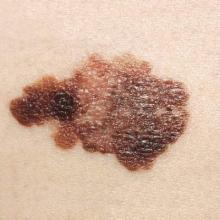CHICAGO – Programmed cell death protein 1 (PD-1) inhibitors and combination ipilimumab and nivolumab prolonged survival, compared with ipilimumab alone in patients aged 80 and older with advanced melanoma, and the patients experienced no more adverse events than did patients of all age groups in prior published phase III studies, according to a retrospective case review.
Of 106 patients included in the current review, 74 received at least 1 dose of the anti–cytotoxic T-lymphocyte antigen 4 agent ipilimumab, 13 received at least 1 dose of an anti–PD-1 agent (pembrolizumab or nivolumab), and 8 received at least 1 dose of combination ipilimumab and nivolumab. Median survival was 7.5 months, 14.2 months, and 23.5 months for ipilimumab, anti–PD-1 agents, and combination therapy groups, respectively. The survival rates at 1 year were 40%, 56%, and 63%, respectively, Dr. Claire Frances Friedman reported at the annual meeting of the American Society of Clinical Oncology.
The differences between the groups did not reach statistical significance, said Dr. Friedman of Memorial Sloan Kettering Cancer Center, New York
Of note, a graphic representation of overall survival by treatment type shows a plateau after 24 months of treatment with ipilimumab (Ipi).
“About 20% of patients treated with Ipi have had a durable survival lasting many years,” she said, noting that this finding is similar to that based on pooled data from a previous study showing a survival rate of 22% with Ipi.
The findings are important because the highest incidence of advanced melanoma is among patients aged 80-84 years, and those over age 75 have a much higher mortality from melanoma, compared with younger patients, she said, adding that “the treatment of advanced melanoma has benefited from great strides in the area of immunotherapy, specifically the use of checkpoint-blocking antibodies.”
These antibodies work by blocking negative regulators of T-cell function, she explained.
The three used in this study are currently approved for the treatment of advanced melanoma. The combination of ipilimumab and nivolumab was approved when it was shown to improve progression-free survival vs. ipilimumab alone.
“Of note, responses to this class of drugs tend to be durable,” Dr. Friedman said.
In a prior study of nivolumab, the 5-year survival rate was 34%, she said.
However, the immune-related adverse events (irAEs) – “a unique set of side effects” associated with checkpoint-blocking antibodies – are concerning. The incidence of high-grade irAEs can vary with the type of checkpoint-blocking antibody – ranging from 16.3% with single-agent anti–PD-1 treatment to 55% with combination treatment in previous reports. The type of irAEs experienced tend to be similar across treatment types, and in a study published in 2015, were associated with a relatively high rate of treatment discontinuation (36.4% for combination treatment, 14.8% with ipilimumab, and 7.7% with nivolumab).
Given the increased mortality and morbidity in older patients, Dr. Friedman and her colleagues were interested in examining the toxicity and efficacy of checkpoint-blocking antibodies in patients aged 80 years and older. They performed the current review involving all patients aged 80 years and older at Memorial Sloan Kettering Cancer Center who were started on checkpoint blockade for stage 3 or 4 unresected melanoma between January 2008 and December 2015.
All patients had at least one infusion visit and one follow-up visit, and 12 of those in the Ipi group received subsequent anti–PD-1 therapy and were included in the toxicity analyses for both agents.
An irAE occurred in 88% of the 74 patients in the Ipi group, and 30% experienced a grade 3 or 4 irAE. The most common high-grade irAEs in this group were diarrhea, transaminitis, and rash.
Of the 25 patients receiving pembrolizumab or nivolumab, 84% experienced any irAE, and 16% experienced a grade 3 event. The most common adverse events in this group were pruritus, rash, fatigue, and musculoskeletal complaints, and one case each of grade 3 lipase, diarrhea, anemia, and nausea occurred.
Of the eight patients who received combination ipilimumab/nivolumab, 88% experienced any irAE and 63% experienced a high-grade 3 or 4 irAE. The most common high-grade irAEs in this group were elevated lipase, diarrhea, and transaminitis, occurring in 38%, 25%, and 25% of patients, respectively.
No deaths occurred in any of the groups, Dr. Friedman said.
The use of systemic steroids to manage irAEs was similar in the Ipi and anti–PD-1 monotherapy groups (28% in both groups), but 75% of the combination therapy patients were treated with systemic steroids. Infliximab was required for diarrhea in 7% of the Ipi patients and 38% of the combination therapy patients. None of the patients in any of the three groups required mycophenolate mofetil for steroid-refractory transaminitis, Dr. Friedman noted.


